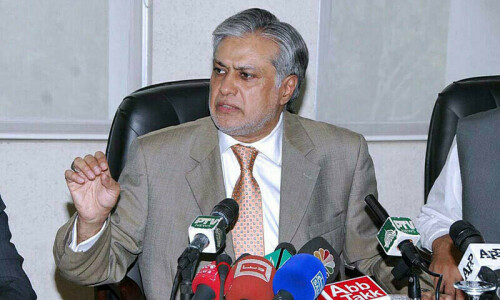 ISLAMABAD, March 30: It was as if smiles and joy had returned to this capital, when in an expression of joy - a celebration of life and its beauty and colour - the National Performing Arts Group hit the stage on Saturday night and communicated the origins, histories and magical legacies of their traditional dance cultures.
ISLAMABAD, March 30: It was as if smiles and joy had returned to this capital, when in an expression of joy - a celebration of life and its beauty and colour - the National Performing Arts Group hit the stage on Saturday night and communicated the origins, histories and magical legacies of their traditional dance cultures.
Heralding the countless pleasures of spring, “Indus rhythm - dances and music of the people of Pakistan” - was a model show of its kind hosted by the Pakistan National Council of the Arts at the National Art Gallery.
Blending modern and traditional music, dances like harvest, Balochi Leva to the fishermen dance and the popular feature of wedding celebrations, Luddi dance, and much more were performed, all under one roof.
It was a magnificent night. The crowd was one harmonious soul despite the needless chattering. And the troupe danced to everything in life and made daily things more beautiful. Featuring nearly 90 minutes, it was as if they danced for the sea, the river, the ruler, for waking up, being sad, losing someone, and falling in love. The National Performing Arts Group made music out of everyday life.
Spurred on by the beat of the dhol and rhythms of the chimta, boys and girls danced Punjabi bhangra with powerful and subtle shoulder, arm, hand and heel movements that could have moved even those for whom growing up desi was difficult enough. The fishermen’s dance captured the rhythm of the fishermen’s life and one of the most popular folk songs of Pakistan, Ho Jamalo dance, described 18th century warrior Jamal Khan Rind, as ten feet tall with flashing red eyes, who defended his homeland against foreign invaders.
Like secret cultural nations pulsing all at once, girls, dressed in their swirling full skirted costumes and silver jewellery, were joined by boys who sang the popular Ho Jamalo in Sindhi Jhoomer dance. Clapping their lacquered sticks together, swinging to the beat of the drum the Dandia (stick) dance came from the soil of Tharparkar.
Instrumental music was also part of entertainment with famous Sarod player Asad Qizalbash and Mohammad Ajmal on tabla. Their musical interlude set an affable conversational tempo and started moving from embellished melody to more adventurous improvisations before coming back down to earth.
And people fell in love with Mohammad Sajid on Sitar and Eid Mohammad on tabla, almost instantaneously, who played music to a packed reverent audience.
“And here’s a chance to celebrate the best of the best on the Pakistani contemporary art scene,” said Asad Niazi who wished for more sitar music.














































Dear visitor, the comments section is undergoing an overhaul and will return soon.